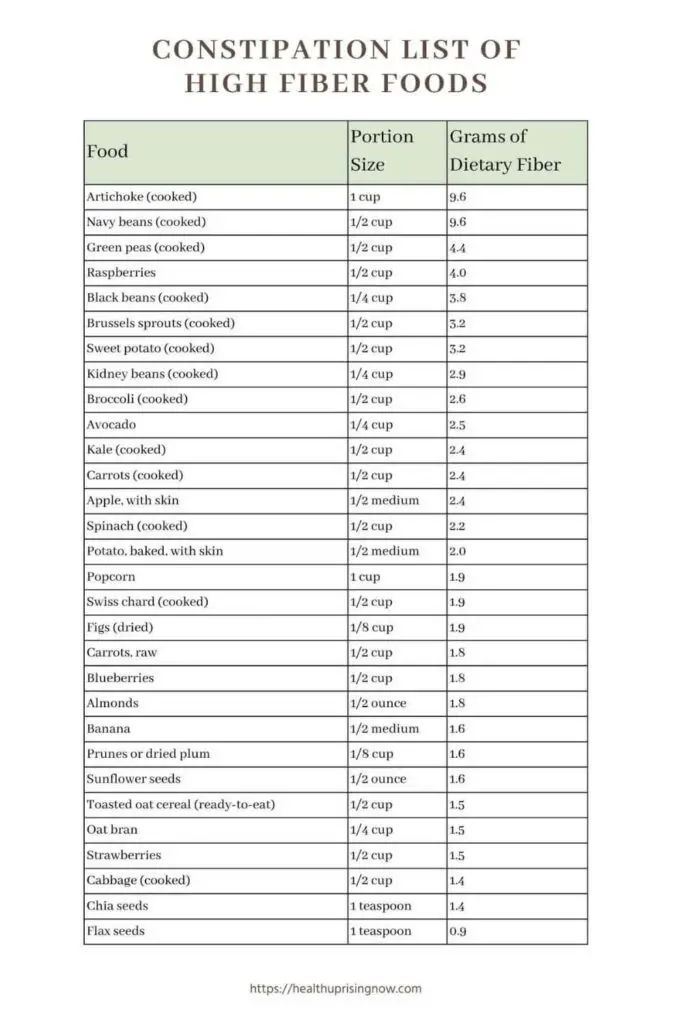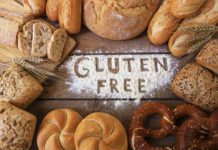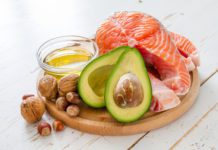Constipation issues are more than just a minor discomfort. For some, 4 million people in the United States to be exact, it’s much more. Chronic constipation can lead to reduced appetite, abdominal cramps, bloating and straining. Increasing your intake of foods for constipation like prunes, beans, and leafy greens, can help relieve digestive discomfort. This article introduces you to the constipation printable list of high fiber foods which you can download for FREE!. This article is Part 1 of a 2-part series on constipation relief.
The information provided is for general informational and educational purposes only. It is not intended as medical advice, and it should not be used to diagnose or treat any health condition or illness. Always seek the advice of a qualified healthcare provider with any questions you may have regarding a medical condition or your individual health.

Table of Contents
What is constipation
Constipation refers to infrequent bowel movements, and is characterized by less than 3 bowel movements in a week. But not all cases of infrequent bowel movements are considered constipation, as you’ll see below.
Constipation can also refer to passing hard or dry stools, or having difficulty passing stools.
Most people suffer from occasional constipation at some point in their lives.
Regular bowel movements vary by individual. For some people, going 2-3 times per week is considered normal. For others, having 2-3 bowel movements a day is normal. It’s important to understand what’s normal for you.
What are the main causes of constipation?
Constipation can be caused by not consuming enough fiber or water, or not getting enough exercise. A change in routine can be a culprit such as when traveling.
People who live a sedentary lifestyle are also prone to constipation.
Occasional constipation can be due to a change in diet. Certain medications and supplements can also be the cause. For example, consuming iron is a well known cause of constipation.
Certain chronic diseases can be responsible for constipation including irritable bowel syndrome, inflammatory bowel disease, diabetes, multiple sclerosis, and hypothyroidism.
How can you tell if you’re constipated
In addition to infrequency and difficulty in passing stools, other symptoms of constipation include feeling bloated, abdominal pain, and straining. Constipation can also cause your stools to look “lumpy”.
For some, constipation may make you feel like you haven’t emptied your stool completely.
Why is constipation bad for overall health
Chronic constipation can cause hemorrhoids and fissures, which are tears in the lining of the anus.
Prolonged constipation can cause fecal impaction and rectal prolapse, a condition where part of the anus protrudes from the rectum.
Some believe that prolonged constipation can result in the buildup of toxins in your body. The premise is that toxins in the stool are reabsorbed into the body.
Others believe that prolonged constipation can lead to hormonal imbalances. Excessive hormones pass through the gut and are excreted with our stool. The belief is that constipation delays the excretion of excess hormones. These hormones eventually get absorbed by the body.
Others believe don’t believe that chronic constipation has any impact on hormones or the buildup of toxins. To that I say, let the science catch up. Not too long there was no scientific evidence that diet impacts autoimmune disease. Now the scientific community has begun considering the impact of inflammatory food on health.
You May Also Want To Read
How to Beat Constipation Naturally: 6 Tips That Don’t Involve Laxatives
Gut Impact on the Immune System: 7 Ways to Restore Gut Health
Best Probiotics for Gluten Intolerance: A Comprehensive Guide
Low FODMAP Diet Provides Proven Results for Multiple Chronic Conditions
How does a high fiber diet help with constipation
Fiber is a type of carbohydrate derived from plant sources like fruits, vegetables, whole grains and legumes. But fiber can’t be broken down completely by human digestive enzymes. As a result it passes through the gastrointestinal tract undigested.
This characteristic of fiber helps to relieve constipation in many ways. Fiber softens stool and increases bulk, making it easier to pass.
Fiber can help to promote intestinal contractions and stimulate bowel movements.
A fiber-rich diet has many health benefits as you’ll see below. But the average American doesn’t consume enough fiber.
According to the Academy of Nutrition and Dietetics, the recommended intake of fiber is about 25 grams daily for women. That’s the equivalent to a cup of cooked beans and a medium avocado.
Older adults require less fiber. That’s because fiber tends to fill us up when we eat, so we eat less. Consuming too much fiber can result in unexpected weight loss for older adults.
High fiber foods for constipation relief that work for me
Years ago I suffered from severe constipation. This was after decades of flip-flopping between constipation and diarrhea due to irritable bowel syndrome (IBS). The constipation was so bad, I would go weeks at a time without going to the bathroom. Or I’d go very little.
My output definitely did not match my input, if you know what I mean.
Nothing worked, not laxatives, stool softeners, even drinking lots of water. My doctor prescribed a few different medicines which either gave me diarrhea or caused some other side effect.
Finally I had enough. With nothing to lose, I decided to take matters into my own hands.
I increased my intake of high fiber foods for constipation relief such as green leafy vegetables. Some of my favorite “bowel busters” are Swiss chard and kale. Bok choy and collard greens are also helpful.
I also increased my consumption of black beans and avocados. I replaced white rice with brown rice, which has more fiber, nutrients and antioxidants. Along with the steps I’ll lay out in Part 2 of this series, these food made all the difference in the world.
Soluble versus insoluble fiber
There are two different types of fiber, soluble and insoluble.
Soluble fiber dissolves in water. Once in the digestive tract, it breaks down into a gel-like texture. This helps to alleviate constipation by softening stool.
Insoluble fiber adds bulk to the stool by absorbing water as it passes through the digestive system. This makes it easier for the stool to move through the digestive system, preventing constipation.
Fiber supplements such as psyllium husk work as a bulking agent that absorbs water in the intestines.
Often, plant based foods will contain both soluble and insoluble fiber, with a higher concentration of one. Eating a wide variety of fiber-rich foods will ensure you get an adequate supply of both. This will help to maintain digestive and overall well being.
It’s important to note that foods high in insoluble fiber can cause bloating, gas, and abdominal cramps in some individuals. This is especially the case when not enough fluids are consumed.
What are some health benefits of a high-fiber diet
The amount of fiber that you consume can have a huge effect on your overall health.
- Minimize the risk of developing colon cancer.
- Soluble fiber such as oat bran, oats and beans, and flax seeds assists in reducing cholesterol levels.
- Fiber rich foods help prevent spikes and crashes in blood sugar levels because it’s not broken down and absorbed the way food is.
- Helps with weight management including weight loss. Fiber isn’t digested. It moves slowly through the digestive tract, causing you to feel fuller longer, so you eat less.
- Supports heart health and reduces the risk of developing cardiovascular disease. This is accomplished by reducing blood pressure, triglyceride levels, and cholesterol levels.
- Great for overall gut health. Fiber acts as a prebiotic, feeding gut bacteria in the digestive tract.
- Insoluble fiber helps reduce the risk of type 2 diabetes as well as Insulin resistance, a precursor to diabetes. It can be found in whole grains, the skins of many fruits and vegetables, nuts and seeds. High soluble fiber slows down digestion and the release of carbohydrates into the bloodstream. This results in the gradual release of glucose into the bloodstream.
Is it possible to eat too much fiber?
Here’s where the old adage, “too much of a good thing is not good” comes into play. Yes, it is possible to eat too much fiber. That’s why it’s important to pay attention to the serving sizes and not to overdo it. Excessive dietary intake can have the following impact.
- Cause bloating, gas, diarrhea, and cramping.
- Interfere with the absorption of specific minerals like iron, zinc, calcium and magnesium.
- Cause unintended weight loss, because it fills you up.
- Trigger symptoms of IBS and IBD.
- Cause dehydration if you’re not drinking enough water.
How to gradually increase fiber
Increasing fiber intake gradually over time is important. This gives your digestive system a chance to adapt. Rapidly increasing fiber intake can result in unwanted symptoms including gas, bloating and abdominal cramps.
The examples below show how you might gradually increase dietary fiber. However, if you have pre-existing medical conditions or concerns, consult with your physician before changing your diet.
- Substitute white rice and pasta with whole grain alternatives.
- Replace at least 1 snack with nuts, seeds, fruit or veggies.
- Add an additional veggie or fruit to your meals.
- Get creative with beans, lentils and peas by including them in salads or main dishes.
- Experiment with different types of fiber.
- Gradually increase portion sizes, especially with beans and whole grains.
- Listen to your body. Your body will let you know whether it agrees or disagrees with your new regimen. Don’t in
Free Constipation Printable List of High Fiber Foods


The listing below is an abbreviated version sourced by Dietary Guidelines for Americans, Food Sources of Dietary Fiber. The list is sorted from the highest amount of dietary fiber to the lowest.
| Food | Portion Size | Grams ofDietary Fiber |
| Artichoke (cooked) | 1 cup | 9.6 |
| Navy beans (cooked) | 1/2 cup | 9.6 |
| Green peas (cooked) | 1/2 cup | 4.4 |
| Raspberries | 1/2 cup | 4.0 |
| Black beans (cooked) | 1/4 cup | 3.8 |
| Brussels sprouts (cooked) | 1/2 cup | 3.2 |
| Sweet potato (cooked) | 1/2 cup | 3.2 |
| Kidney beans (cooked) | 1/4 cup | 2.9 |
| Broccoli (cooked) | 1/2 cup | 2.6 |
| Avocado | 1/4 cup | 2.5 |
| Kale (cooked) | 1/2 cup | 2.4 |
| Carrots (cooked) | 1/2 cup | 2.4 |
| Apple, with skin | 1/2 medium | 2.4 |
| Spinach (cooked) | 1/2 cup | 2.2 |
| Potato, baked, with skin | 1/2 medium | 2.0 |
| Popcorn | 1 cup | 1.9 |
| Swiss chard (cooked) | 1/2 cup | 1.9 |
| Figs (dried) | 1/8 cup | 1.9 |
| Carrots, raw | 1/2 cup | 1.8 |
| Blueberries | 1/2 cup | 1.8 |
| Almonds | 1/2 ounce | 1.8 |
| Banana | 1/2 medium | 1.6 |
| Prunes or dried plum | 1/8 cup | 1.6 |
| Sunflower seeds | 1/2 ounce | 1.6 |
| Toasted oat cereal (ready-to-eat) | 1/2 cup | 1.5 |
| Oat bran | 1/4 cup | 1.5 |
| Strawberries | 1/2 cup | 1.5 |
| Cabbage (cooked) | 1/2 cup | 1.4 |
| Chia seeds | 1 teaspoon | 1.4 |
| Flax seeds | 1 teaspoon | 0.9 |
A registered dietician can provide guidance by setting a daily fiber goal. The two of you can work together on selecting high fiber foods to meet this goal.
To download your free Constipation List of High Fiber Foods, enter your email address and first name in the fields below, the click SEND MY FREE COPY NOW!
Summary
Adding high-fiber foods for constipation relief is a natural and effective way to promote overall digestive health. Fruits, vegetables, whole grains and legumes are all great sources of fiber. By softening stool and adding bulk, fiber helps to facilitate the passing of food through the gastrointestinal tract. Download your FREE constipation printable list of high fiber foods and gradually incorporate these foods in your diet. Remember, small dietary changes can have a significant impact on your digestive, and overall well-being. Be sure to check out How to Beat Constipation Naturally: 6 Tips That Don’t Involve Laxatives.























